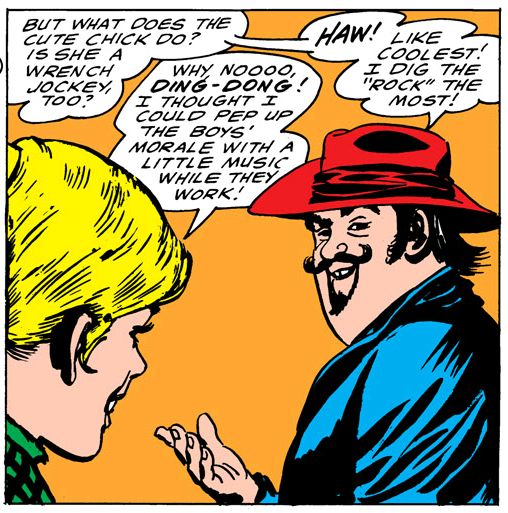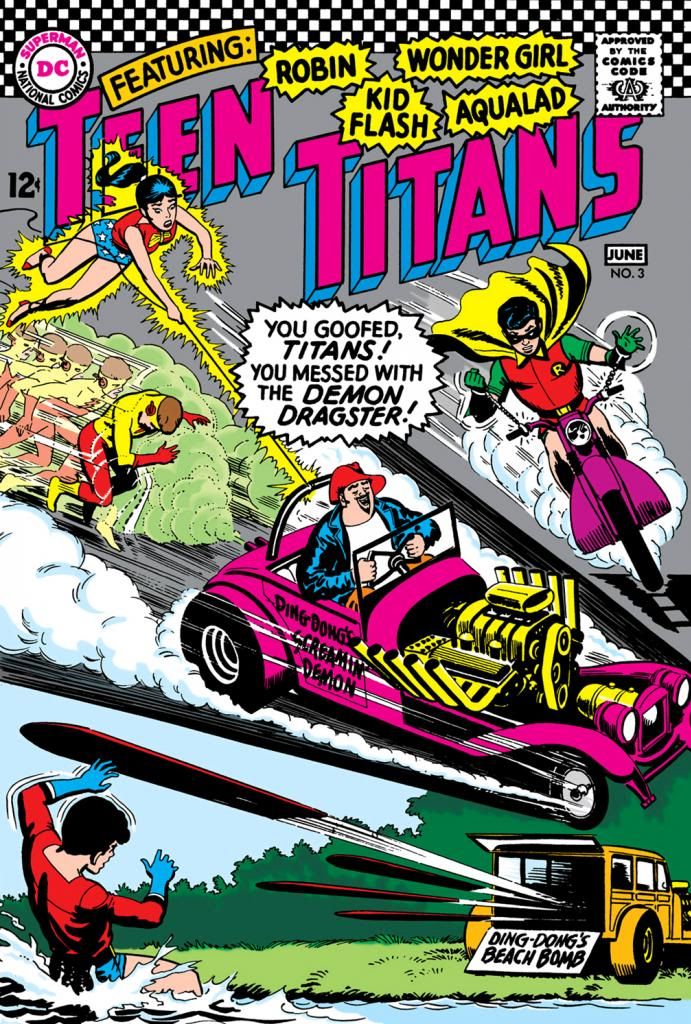Anyway, "The Revolt at Harrison High," from Teen Titans #3 (June 1966), finds the Johnson administration trusting its anti-drop out initiative to a group of costumed kids who, if we measured IQ in houses, would have to climb up out of the basement to get to stupid. The Teen Titans in this issue are ultra-establishment types who believe when Uncle Sam says "Jump!" you jump, right across the Pacific into Southeast Asia where, if you're lucky, you come back minus just your innocence or part of your leg. Or in this case, to Harrison, USA, where statistically average teen David Robinson has dropped out of school and taken to spinning around town in a souped-up jalopy while working for Ding-Dong Daddy, who just happens to be a dead ringer for Ed Roth.
The Titans don't do much to prove me wrong about their intelligence in this issue. As soon as Robin hears about David's employer, he has the team check out Ding-Dong Daddy's Hot Rod Hive, which is a pretty obvious move. There Dowd-- a mountain of a man much like his real-world inspiration-- comes on way too strong with hip cat talk and his refusal to show anyone his secret room. Once again, the barely-sentient Robin senses something amiss-- I mean, secret room!-- and sends Kid Flash vibrating through the steel door to find a group of teen-aged boys doing what teen-aged boys do best.
No, not that. Are you kidding me? They'd go blind! Plus, that's more a hygiene issue and this is about societal ills. What these out of sight groovesters are doing is equipping an ice cream cart with a machine gun to kill cops. Robin knows this is all kinds of wrong, so he has the Titans beat a hasty yet nonchalant retreat so they can plan the next step. After tangling with a trio of Ding-Dong Daddy's hot rods and losing, the Titans disguise themselves as some less-than-convincing motorcycle toughs so they can help Danny and his no-good pals fight an even worse scourge of wholesome American highways-- an honest-to-goodness motorcycle gang called the Scorchers. The Scorchers wouldn't survive ten seconds in a rumble with the Hell's Angels. I doubt they'd last much longer against the Black Widows. Our favorite teens soon subdue the Scorchers and impress David and pals enough they help the heroes infiltrate the Hot Rod Hive where Wonder Girl-- her hair bleached blond-- entertains Ding-Dong Daddy by dancing away in his office and the boys fight some goons and a robotic gas pump.
 |
| You sleaze! You're more than twice her age! (Bob Haney, script/Nick Cardy, art, Teen Titans #3) |
There's even a nasty little double-entendre a few moments earlier when Ding-Dong Daddy asks, "But what does the cute chick do? Is she a wrench jockey, too?" This sets up a scene where Wonder Girl leads Ding-Dong Daddy by the arm to his office-- both figures largely silhouetted in a sinisterly suggestive way-- to "keep him occupied" (Robin's phrase, not mine). Once in the office, our bold young Amazon gyrates away while Ding-Dong Daddy, obviously middle-aged, leers at her and declares, "Haw! I like it, babe!" But the creep soon gets his as Wonder Girl takes him down herself and everyone agrees to return to school. Two years later, David Robinson gets his draft notice and it's off to Cu Chi with the 25th Infantry Division. But that's a Titans tale for another time!
Of course, there are few things less cool than middle-aged men trying desperately to capture the youth zeitgeist, but paradoxically, there are also few things cooler. Stan Lee somehow managed to do it with ease by using a lot of WW II-era GI slang ("Hang tough!" and "Face front!" come to mind), but DC never quite got with it despite their best efforts. Bob Haney lays on the teen-talk pretty thick throughout this issue, which dates it (along with its super square, pro-establishment naivete, which no doubt dated it even in 1966), but it's that very product-of-its-time quality that makes these early Teen Titans issues such fun. Like, baby, I dig Teen Titans the most! And that includes the pop-art checkerboard design on the cover.
That and the use of a Roth stand-in as the villain. Which, my friends, is inspired. The only thing that could have been better would have been a Bob Dylan-esque folk singer pushing pot to Robinson and pals. Okay, Haney never would have gotten that one past the Comics Code. Roth and his hot rod culture were pretty popular around this time-- DC comics frequently included ads for toys based on his designs-- and he was such a colorful figure in his own right. Plus, using a Roth avatar gives Nick Cardy the chance to go absolutely nuts with crazy custom car designs- one has bank-robbing mechanical tentacles, even-- and whacky motorcycle gang outfits.
Come to think of it, if Ding-Dong Daddy hadn't been a villain, he would have made the perfect protagonist for his own title. That is, if you took away his pervy "barely legal" predilections. Of course, it would have flopped like a lot of DC's youth-pandering efforts did later in the 60s and early 70s when they got ever more desperate to stem the Marvel tide and capture some of those Baby Boomer bucks, but then we'd have more Ding-Dong Daddy material to talk about and there's nothing wrong with that.
It's just too bad they couldn't have worked in some version of Rat Fink as Dowd's side-kick in place of some unfortunately generic thugs-- so dull I initially mistook one for David, who sports a white tee and jeans throughout. Yawn!-- who beat up Robin.
These early Titans issues are nothing if not socially conscious, as well. Which is fitting considering the book's young cast and the tumultuous times in which these books first appeared. Even though it's handled less subtly than in one of those classroom films we used to watch in PE on rainy days during junior high, Haney and Cardy don't let their preachy anti-drop out message get in the way of a lot of frantic action, with the dread Batman in his Batmobile getting his ass handed to him by Ding-Dong Daddy's technologically superior automotive stylings, Robin handcuffed to a "hot Honda" (a phrase which tickled Haney so much he uses it again later in the book), which nearly speeds him to his death, Kid Flash running in place to save a school bus full of teens and Aqualad falling prey to a car that shoots flying surfboards. They just awkwardly toss the message into the dialogue and let the story continue on its rambunctious way.
We're having fun, but I can't shake the feeling Haney really hoped he might reach a few at-risk kids with this comic and do some real-world good. That kind of kind heartedness counts a lot with me, especially looking back from a vantage point where so many of today's books seem simply negative for negativity's sake, crass, the results of lowest-common-denominator thought, or cynical attempts to exploit headlines for controversy. Haney probably wrote this with an eye on the headlines as well, but his mission wasn't simply to profit from them. Instead, I get the idea he hoped to find some constructive way for silly superheroes to have a positive impact on their readership, rather than just confirm them in their downbeat pessimism.
Realistically, this comic probably did little if anything to convince readers to stay in school or trust the Johnson administration. On the other hand, it must have sent more than a few of them in search of CARtoons magazine.


No comments:
Post a Comment